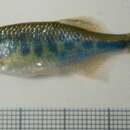en
names in breadcrumbs


The barred danio (Devario pathirana) is a fish belonging to the minnow family (Cyprinidae). Originating in Sri Lanka, this fish grows to a maximum length of 2 inches (6 cm).
In the wild, the barred danio is understood to be critically endangered, but is freely available from captive-bred stock. Typically, the fish prefer water with a 6.0-8.0 pH, a water hardness of 5.0-19.0 dGH, and an ideal temperature range of 69-79 °F (20-26 °C). Its diet consists of annelid worms, small crustaceans, and insects. The barred danio is oviparous (an egg layer), and is found mostly in the Nilwala River basin.[2]
The barred danio (Devario pathirana) is a fish belonging to the minnow family (Cyprinidae). Originating in Sri Lanka, this fish grows to a maximum length of 2 inches (6 cm).
In the wild, the barred danio is understood to be critically endangered, but is freely available from captive-bred stock. Typically, the fish prefer water with a 6.0-8.0 pH, a water hardness of 5.0-19.0 dGH, and an ideal temperature range of 69-79 °F (20-26 °C). Its diet consists of annelid worms, small crustaceans, and insects. The barred danio is oviparous (an egg layer), and is found mostly in the Nilwala River basin.